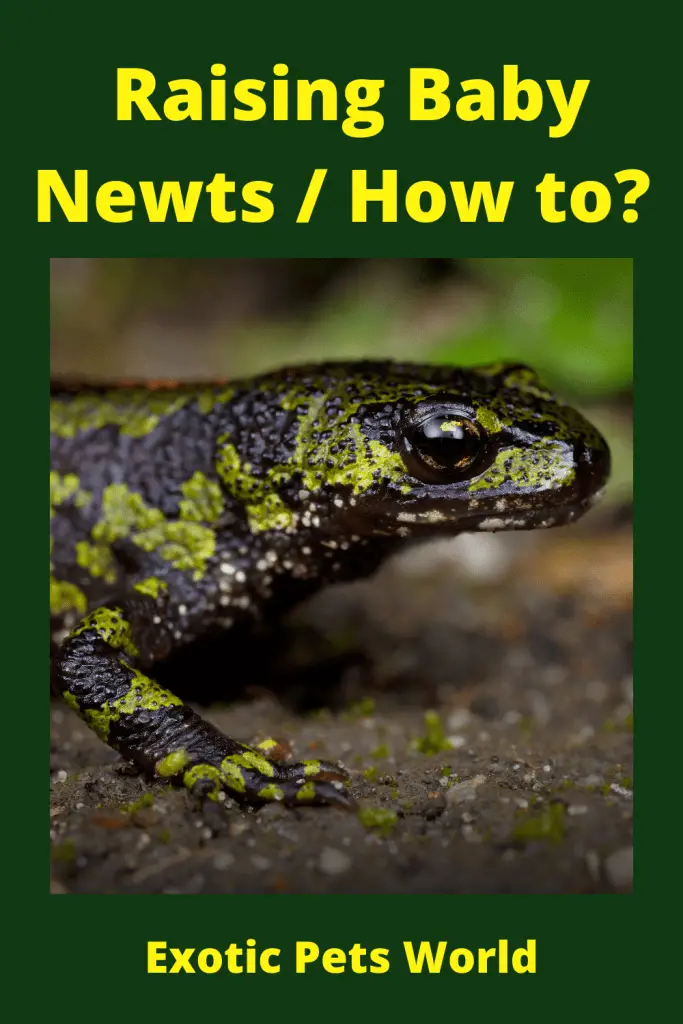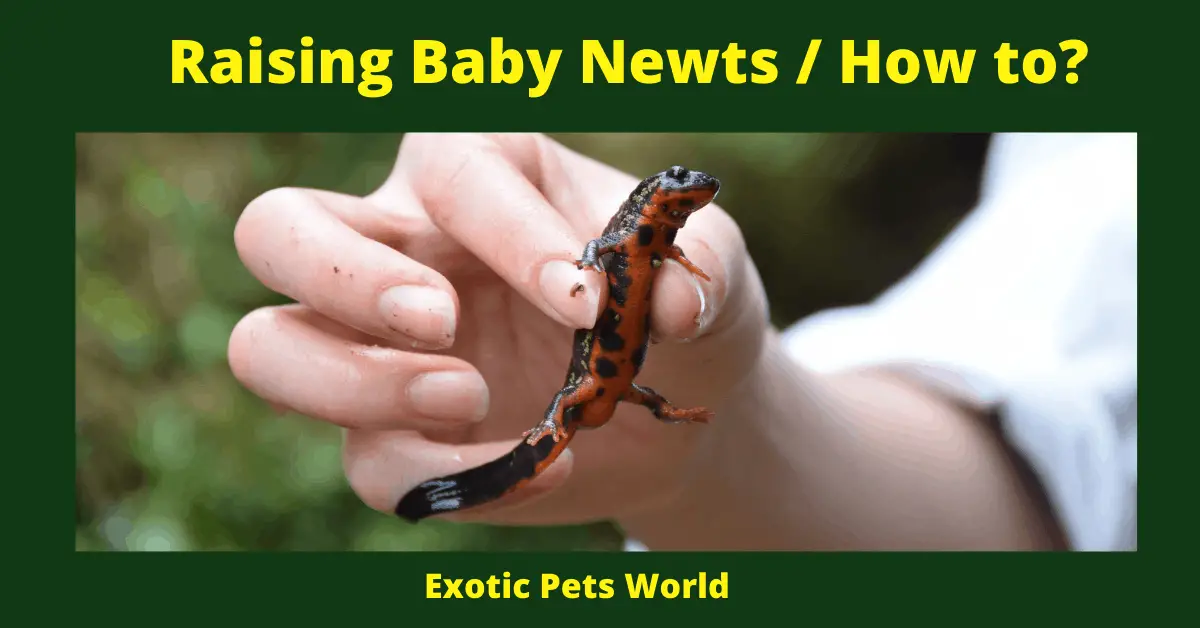How to begin raising baby newts. . A newt is a lizard in the subfamily Pleurodelinae. The terrestrial adolescent stage is called an eft. In contrast to different individuals from the family Salamandridae, newts are semiaquatic, switching back and forth among sea-going and earthbound living spaces. Not all oceanic lizards are viewed as newts.
Newts transform through three particular formative life stages: aquatic larva, terrestrial juvinile (eft), and grown-up or adult.
Raising Baby Newts/ Breeds of Newts
Newts are sometimes mistaken for reptiles, yet they are unquestionably not these reptiles since they have no scales, just slight, clammy skin through which they can exchange gases and breathe, and they move much slower than them. Also, lizards, similar to all reptiles, don’t breed in water.
The normal temperature of Newts lies between 60-75°F. They attain maturity at 3-5 years of age. At that time they leave the land and enter the water for breeding. The average lifespan is 6 years but they may survive up to 20 years.

There are three types of newts found in Britain – all local. These are the common or smooth newt, the great crested newt, and the palmate newt.
1) Common Newt
(Triturus vulgaris): Also called as smooth newt, this newt is the most boundless among the three species, discovered predominantly in marsh habitat. It is the only newt that is present in Ireland. It has delicate, smooth skin and a long tail, straightened along the edges.
From head to the tip of the tail, the regular newt measures about 10cm (4in.). Typically, it is a yellow-olive tone, however, in the reproducing season, the male turns out to be a lot brighter, with an orange underside and spotted throat and stomach. He additionally grows a peak down his back and tail.
Common newts spend summer, fall, and winter on land in natural surroundings, for example, open forest, lush pasture, and gardens, not a long way from their breeding lakes.
During the day they cover up under logs or stones or in thick grass. They come out on moist evenings to chase for their food. Like all newts, common newts eat a wide assortment of prey, which they get greedily and gulp down. Their eating routine incorporates snails, slugs, insects, worms, – and other newts!

In winter, all newts sleep, generally under logs, or stones, never a long way from the water. In late-winter, about March or April, common newts move to their rearing lakes – they favor genuinely profound lakes – to mate and lay their eggs.
In contrast to frogs and amphibians, they don’t lay eggs in masses or strings, however, the female wraps each egg independently in the folds of a water plant leaf. This assists with shielding the egg from predators.
A female newt lays around 300 eggs, so the egg-laying measure requires her numerous hours. Newt tadpoles look like little monsters with feathery gills. Front legs are developed around fourteen days after incubating, and the rear legs grow soon after them.
They feed on mini water animals, for example, water worms and fleas, and even go after more modest newt tadpoles. Toward the finish of the summer the full-fledged, mini newts leave the water to live on the land. At the point when they are two years of age, they re-visit the water to raise.
Just around six out of each 300 will figure out how to arrive at maturity- a large portion of them fall prey to hunters, for example, grass snakes, rodents, blackbirds, and hedgehogs.
2) Palmate Newt
(Triturus helveticus): this newt is the littlest British newt, about 7.5cm (3in.) long, and is, for the most part, found in heathland or upland habitats.
The palmate newt is different in colour to the common newt, however, in the reproducing season, the male palmate creates black or dark webs on his rear feet, a short fiber toward the end of the tail, and his underside is plain instead of spotted. It is difficult to differentiate the females of the two species.
3) Great Crested Newt
(Triturus cristatus): this is the biggest British newt, about 16cm (6.5in.), and is otherwise called the warty newt. It is currently extremely uncommon, discovered uniquely in a couple of regions of swamp England, for the most part of the south and east. It is very rarely found in Scotland and Wales.
The skin of the extraordinary peaked newt isn’t as smooth as that of the other two species; it is warty (rough) and practically dark in shading, with a dark-spotted golden underside.
In the rearing season, the male grows a high, toothed peak along with his back and tail and silver streaks on his tail. Like different newts, the male waves his tail and peak during romance attract and dazzle the females.

Feeding Newt
A well balanced Newt diet comprises of:
- Aquatic- saltwater shrimp, bloodworms, live and frozen slashed night-crawlers.
- Terrestrial – Give an assortment of insects, including gut-stacked (freshly fed) crickets, mealworms, white worms, and tubifex worms.
- Commercial diets can also be given.
Things to Keep in Mind When Taking Care of a Newt
- Clean, Fresh, chlorine-free water ought to be accessible consistently.
- Feed adolescent Newts day by day, grown-ups all other days.
- Sprinkle food with calcium supplement day by day and a multi-vitamin enhancement once or twice a week.
Can Baby Newts Eat Fruits?
They may try to eat fruits or human food. Although they won’t see it as their food, even if they try to eat it they won’t be able to digest it. Only provide food of their natural habitats like bugs or some other invertebrates.
What Happens if You Touch a Newt?
With its uneven skin that goes in shading from dark grey to reddish-brown, the rough-skinned newt (Taricha granulosa) is attractive, yet don’t get it for a more intensive look. To protect itself, this amphibian can create a powerful poison from its skin.
Although they produce tetrodotoxin, fire-bellied newts are quite safe comparatively if some precautions are used.
Can Newts Live in Tap Water?
- Aquatic newts are remarkably interesting pets and exceptionally simple to keep up. They are generally active and entirely affable. To remain healthy, they should be dealt with appropriately. The most ideal approach to deal with your aquatic newt is to set up the legitimate aquarium and keep it clean.
- Water should be dechlorinated as Chlorine and other chemicals will harm or kill your newt.
- You can also use spring water. Never use tap water directly as it contains chemicals. Let tap water sit for 48 hours so that all the chemicals get evaporated before being added to newt’s container.
- Use a filter in newts container for continuous cleaning of water.
- You can line the tank with gravel of size larger than newt’s feet. It should be smooth so as not to cut their feet.
- The Aquarium should be covered with a mesh lid to provide proper ventilation and prevent the escape of newt.
Do Newts Need a Heat Lamp?
In contrast to reptiles, newts and lizards don’t need heat lights for lighting. Warmth lights may kill newts and lizards by causing desiccation. Normal light can be utilized, given that daylight doesn’t radiate straightforwardly into the tank since this can warm the tank over the protected temperature range.
Some say Newts need full range lighting with UVB beams. It ought to be turned on for 10 to 12 hours every day. You can put it on a clock so your newt consistently gets the legitimate measure of light.

Do Newts Bite?
Yes, they do bite. But, Newt bites aren’t anything to stress over, you scarcely even feel them and possibly get them if your hands are in place they shouldn’t be (of course there are times when it is totally important to deal with them.)
Do Newts Carry Diseases?
They may carry Salmonella infection. Therefore they can’t be a choice as a pet if there are young children at home or with weak immune systems.
- Always wash your hands and face after touching or dealing with the newt.
- Avoid contact with newt with children.
- Don’t let newt roam in areas like kitchen or pantries to avoid spreading the infection.
How Long Can Newts Go Without Eating?
Newts should not be kept starved, (without Food) for more than 4 days. Regularly give them adequate feed and water so that there won’t be any chance or situation of mishappening.
Conclusion
Newts undergo metamorphosis and they are also seen as bioindicators due to their thin and sensitive skin to the environment. Newts are threatened by territory or habitat loss, pollution, and fragmentation. A few animal species are endangered, and at least one species, the Yunnan lake newt, has become extinct in recent times.
